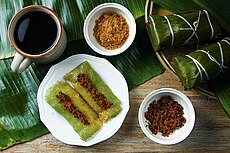Suman (food)
 Suman sa lihiya, a variety of suman wrapped in banana leaves. | |
| Alternative names | Rice cake |
|---|---|
| Place of origin | Philippines |
| Main ingredients | Glutinous rice |
Suman, or budbud, is an elongated rice cake originating in the Philippines. It is made from glutinous rice cooked in coconut milk, often wrapped in banana leaves, coconut leaves, or buli or buri palm (Corypha) leaves for steaming. It is usually eaten sprinkled with sugar or laden with latik. A widespread variant of suman uses cassava instead of glutinous rice.
Varieties
[edit]There are numerous varieties of suman, with almost every town or locality having its speciality. Some are described below:[1]
- Binuo (or Suman sa Binuo) – A rare variety of suman, the glutinous rice is soaked, milled, mixed with coconut milk and sugar, wrapped in the leaves of the Tagbak plant, and steamed. The leaves give this variety of suman a uniquely balmy, minty flavor, and the suman itself is chewier than the whole-rice varieties.
- Kurukod or kurukud - A type of cassava suman with a filling of sweetened grated coconut (bukayo).[2]
- Moron (or chocolate suman) - A type of glutinous rice suman mixed with chocolate tablea (tablets) or mixed with cocoa powder. Most versions of moron has the chocolate suman twisted with the regular suman. It hails from Eastern Visayas among the Waray people especially around Tacloban City in the province of Leyte.
- Palagsing - A local variety of suman from Butuan using unaw starch, or sago, and often with pieces of coconut. It bears a characteristically red color and has a sweeter taste. This dish is known as Suman Ukaw (and also as Ambulong Suman or Amboeong Suman) in Aklan.
- Suman sa Ibus (or simply Ibus)[3] – A ubiquitous variety of suman in the Philippines, the glutinous rice is washed, and is then mixed with salt and coconut milk. The mixture is poured over pre-made coil containers of young palm leaves called Ibus or Ibos, and fixed with the leaf's central shaft. This is then steamed using water mixed with "luyang dilaw" (turmeric)—giving it that distinctly yellow colour—and served either with a mixture of shredded coconut and sugar, or latik (reduce coconut milk until white lumps form and simmer until golden brown).
- Sumang Inantala – The ingredients are similar to the Ibus variety, but the Inantala differs in that the mixture itself is cooked, and then poured over a small square mat cut from banana leaves.
- Sumang Kamoteng Kahoy[4] – Cassava is finely ground, mixed with coconut milk, sugar, wrapped in banana leaves, and steamed.
- Suman sa Lihiya[5] – Soaked glutinous rice mixed with coconut milk is treated with lye, wrapped in banana leaves, and boiled for two hours. It is served especially with either of two varieties of latik—the brown one which has been darkened with extended cooking and has a stronger coconut flavor, or the white one which is more delicate in taste. Also known as Akap-akap from the way it is bundled and sold; it is usually sold in pairs, hence the name.
- Sumang Inilonggo – Refers to Biko in Hiligaynon/Ilonggo as opposed to the traditional suman.
Suman wrapping
[edit]Suman wrapping is a unique art in itself, and can be traced to pre-colonial roots which have had contact with Indian traditions. Wrappers utilize a wide variety of indigenous materials such as palm, banana, anahaw and bamboo leaves, coconut shells, and others. Some wrappings are simple folds such as those found in the binuo and the kamoteng kahoy, resulting in rectangular suman. Others are in vertical coils like the inantala, giving it a tubular form. Still others are in pyramid-like shapes, like the balisungsong. Some forms of suman are eaten like ice cream–with cones made from banana leaves, and still others are in very complex geometric patterns like the pusu ("heart"). Some are woven into the shape of a banana blossom (which in the Philippines is referred to as the banana plant's "heart"), or the pinagi (from the word pagi, meaning stingray), a complex octahedral star.[1]
Suman dishes (as well as savory variants like binalot and pastil) are differentiated from pusô (or patupat), in that the latter use woven palm leaves.[1][6]
Gallery
[edit]-
Two varieties of suman (glutinous rice and cassava)
-
Suman sa Ibus
-
Suman sa Lihiya
See also
[edit]- Pusô
- Tupig
- Espasol
- Kakanin
- Kalamay
- Moron
- Puto
- Sapin-sapin
- Piutu
- Lepet
- Khao tom
- List of steamed foods
References
[edit]- ^ a b c Nocheseda, Elmer I. "In Praise of Suman Past". Tagalog Dictionary. Retrieved January 27, 2008.
- ^ Sison, Jainey (August 18, 2017). "KURUKOD (Cassava Suman with Coconut Filling)". Mama;s Guide Recipes. Retrieved October 5, 2019.
- ^ "Suman sa Ibus Recipe". Retrieved December 24, 2007.
- ^ "Cassava Suman Recipe by Pinoy Recipeat iba pa". Retrieved April 12, 2012.
- ^ "Suman sa Lihiya Recipe". Retrieved October 16, 2013.
- ^ Nocheseda, Elmer I. (2011). "The Art of Pusô: Palm Leaf Art in the Visayas in Vocabularios of the Sixteenth to the Nineteenth Centuries" (PDF). Philippine Studies. 59 (2): 251–272.





